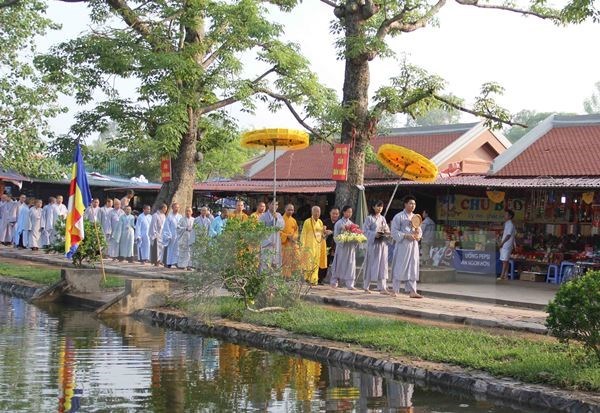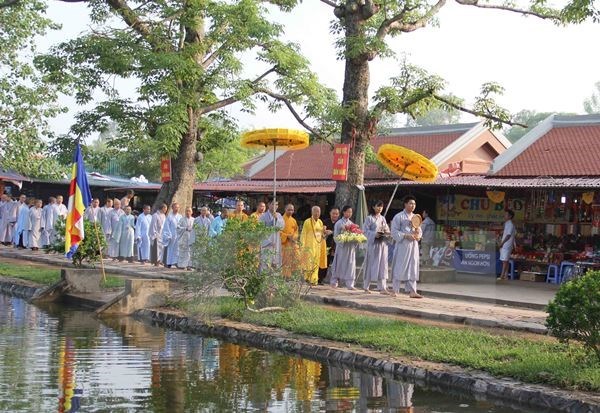
Vu Thu district in the northern province of Thai Binh held a ceremony on October 29 to begin Keo Pagoda festival and receive a certificate recognising it as national intangible cultural heritage.

Buddhist offerings - a ritual of Keo Pagoda festival
(Source: VNA)
The festival is held
annually from the 10th to 15th day of the ninth lunar month to honour Zen
Master Khong Lo (1016-1094) – founder of the Keo Pagoda.
It features religious rituals and communal activities such as Buddhist
offerings, palanquin parades, love duet singing on boats, and folk games.
Speaking at the event, Deputy Minister of Culture, Sports and Tourism Dang Thi
Bich Lien asked Thai Binh province to complete a project to preserve and
develop the festival.
The relic site management board and Vu Thu district authorities were asked to
ensure safety and order for the festival and promote its values to visitors.
Keo pagoda was founded in 1061. After it was swept away by a flood in 1611, the
pagoda was rebuilt in 1632 and most of its architectural features, including 17
structures with 128 rooms, remain until today. In 2012, it was recognised as a
national special relic site.
In addition to the autumn festival, another spring festival takes place here
annually on the 4th day of the first lunar month.
The pagoda attracts more than 2,500 visitors to Thai Binh every year.-
Source: VNA
With an increasingly vibrant and widespread emulation movement aimed at building cultured residential areas and cultured families, Yen Thuy District has been making steady progress toward improving both the material and spiritual well-being of its people, while fostering a civilized, prosperous, beautiful, and progressive community.
Once lacking recreational spaces and community facilities, Residential Group 2 in Quynh Lam Ward (Hoa Binh City) has recently received attention for the construction of a new, spacious, and fully equipped cultural house. The project followed the model of state support combined with public contributions in both labor and funding.
The "All people unite to build cultural life" movement, which has been effectively integrated with Kim Boi district’s socio-economic development goals, is fostering a lively spirit of emulation across local residential areas, hamlets, villages, public agencies, and enterprises. In addition, through the initiative, traditional cultural values are being preserved and promoted, while community solidarity and mutual support in poverty reduction and economic development are being strengthened.
A working delegation of the Hoa Binh provincial People’s Committee led by its Permanent Vice Chairman Nguyen Van Toan on June 11 inspected the progress of a project to build the Mo Muong Cultural Heritage Conservation Space linked to tourism services in Hop Phong commune, Cao Phong district.
Born and growing in the heroic land of Muong Dong, Dinh Thi Kieu Dung, a resident in Bo town of Kim Boi district, in her childhood was nurtured by the sweet lullabies of her grandmother and mother. These melodies deeply imprinted on her soul, becoming an inseparable part of her love for her ethnic group's culture. For over 20 years, this love for her hometown has driven Dung to research, collect, and pass down the cultural values of the Muong people to future generations.
In the final days of May, the Ethnic Art Troupe of Hoa Binh Province organized performances to serve the people in remote, mountainous, and particularly disadvantaged areas within the province. These were not just ordinary artistic shows, but they were the meaningful journeys aimed at spreading cultural values, enhancing the spiritual life of the people and contributing to the preservation of ethnic minority cultural identities.



